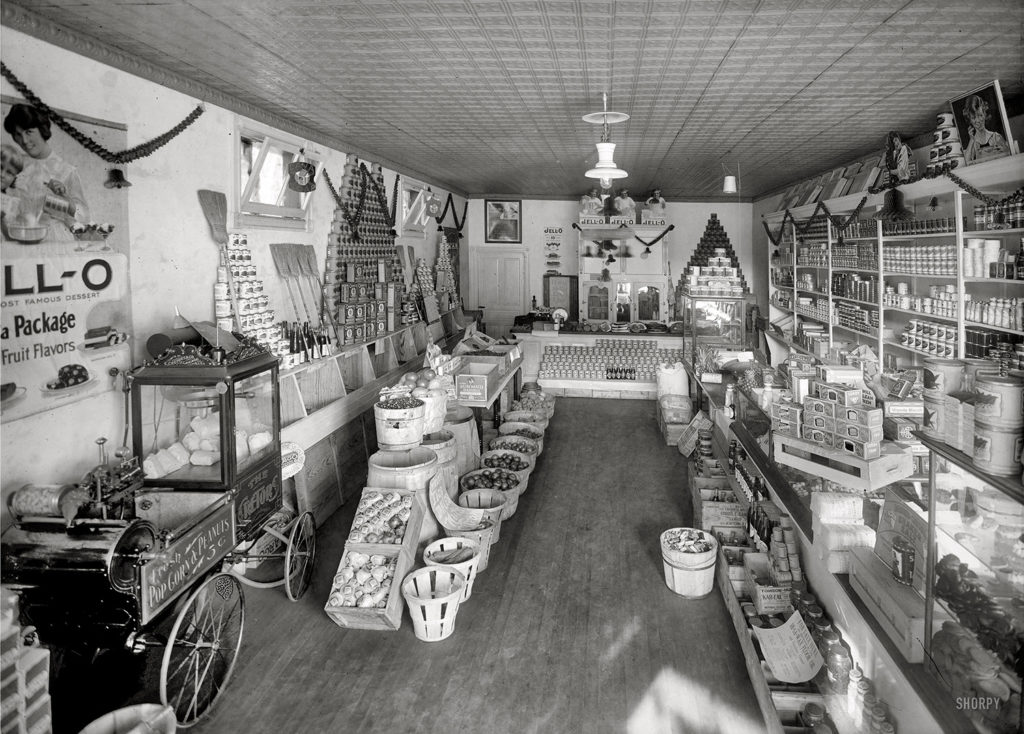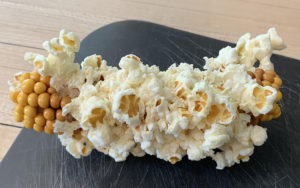OLD MAIDS, MUSHROOMS & BUTTERFLIES
Popcorn has been around for centuries. Ceremonial wreaths, necklaces, and ornaments on the statues of Aztec gods contained ears of popcorn, corn kernels, and popped flakes Native American dance rituals of various indigenous peoples included corsages and headdresses made with ears of popcorn, corn kernels, and the flowery petals of popped kernels. The Iroquois and other tribes believed that quiet, contented, spirits lived within each kernel. These spirits become angry when their peaceful kernel home became too hot. Exhibiting their displeasure, a popcorn spirit danced aggressively, resulting in the spirit’s kernel home jumping about. Eventually the corn kernel exploded as the outraged spirit exited his home in a flash of smoke (steam water vapor) to seek a more comforting kernel home.
 Later this month, on January 21st at 7 PM, the first program of 2021’s Behind the Steam series will occur. The topic is the Cretors Steam Popcorn Popper and how Charles Cretors’s first steam-powered peanut roasting machine, constructed in 1885, became the start of a family-owned business into the 21st century. Pictured right: an electric Cretors Popcorn Machine at the F.G. Lindsay Store circa 1925, Washington, D.C. (Shorpy Photographs).
Later this month, on January 21st at 7 PM, the first program of 2021’s Behind the Steam series will occur. The topic is the Cretors Steam Popcorn Popper and how Charles Cretors’s first steam-powered peanut roasting machine, constructed in 1885, became the start of a family-owned business into the 21st century. Pictured right: an electric Cretors Popcorn Machine at the F.G. Lindsay Store circa 1925, Washington, D.C. (Shorpy Photographs).
The worldwide popcorn market, including both ready-to-eat and pop-it-yourself categories, is projected to reach $15 billion by 2023. The popcorn we enjoy today is grown to ensure very few “old maids” (unpopped kernels) and that the endosperm (soft core material) within each pericarp (shell) explodes into the largest butterfly or mushroom shape possible. Americans love to lather on butter, caramel, salts, and seasonings to enjoy this tasty snack.
Without the benefit of Cretors’ machinery that revolutionized the consumption of popcorn, how did Native Americans and even early American settlers prepare popcorn?
Answer
Before the introduction of Charles Cretors’s machinery, popping corn was not a simple task. Ideally a harvested kernel stripped from a corn cob needs to contain around 14% moisture. A kernel’s typical popping temperature is near 350° Fahrenheit. As the kernel’s temperature rapidly rises past 212° Fahrenheit, the encapsulated endosperm moisture transforms to steam and pressure builds within the pericarp. When the steam pressure within the kernel reaches approximately 130 pounds per square inch, the shell violently ruptures while the steam entrapped within the endosperm explosively expands the soft endosperm material forming the classic mushroom or butterfly shape. A popped kernel is referred to as a “popcorn flake.”
Due to the pericarp’s impervious characteristics, the eating of unpopped popcorn kernels may break teeth and do not digest in our stomachs, resulting in intestinal pain and discomfort. Native Americans placed kernels in a mortar and crushed them with a pestle to form a flour. Sifted through coarse cloth to remove shell fragments and debris, the flour can be mixed with milk, honey, fruit, and similar flavorings and served as a morning meal. Popcorn soup made from the popped kernels was enjoyed by the Iroquois and other tribes. Popcorn flour was dried and mixed with honey to form a biscuit for consumption on hunting trips providing quick nourishment similar to a shack.
 Native Americans formed large shallow flat clay pans that they could set on rocks atop a hot bed of embers. The bottom of the pan was lightly covered with corn kernels followed by covering the kernels with a thin layer of coarse sand or fine gravel to insure uniform heating of the kernels. An earthen or bark cover kept the kernels from leaving the vessel upon popping. Once the last of the ‘spirits’ vacated the kernels, the pan was removed and the popped corn kernels were picked out, the sand/gravel blown off, and eaten. Alternatively, a couple ears of corn might be placed in an earthen crock filled with coarse sand or fine gravel where the kernels popped on the cob (pictured).
Native Americans formed large shallow flat clay pans that they could set on rocks atop a hot bed of embers. The bottom of the pan was lightly covered with corn kernels followed by covering the kernels with a thin layer of coarse sand or fine gravel to insure uniform heating of the kernels. An earthen or bark cover kept the kernels from leaving the vessel upon popping. Once the last of the ‘spirits’ vacated the kernels, the pan was removed and the popped corn kernels were picked out, the sand/gravel blown off, and eaten. Alternatively, a couple ears of corn might be placed in an earthen crock filled with coarse sand or fine gravel where the kernels popped on the cob (pictured).
While only the wealthiest American settlers might have access to one of Benjamin Thompson’s (inventor of the thermos bottle as well!) early 1800’s stove designs, cast iron stoves became widely available in the mid-19th century, consuming wood or coal for fuel. For most Americans, cooking was performed at open hearth fireplaces or at a classic campfire-type configuration until the 1900s. Popcorn was often cooked over an open fire, including a cabin fireplace heating the structure, in enclosed wire baskets. Where covered pans were used, in place of sand or gravel, animal derived oils of the day such as bacon fat, lard, or tallow were used. Cretors’ invention was based around a steam engine continuously agitating the corn kernels at a controlled temperature in a pan containing special blend of fats, oils, and ingredients. The cooking aroma from Cretors’s secret blend of bacon fat, butter, salt, and seasonings transformed popcorn from a novelty to a mainstream snack food. Cretors graduated popcorn to being about the sights, sounds, and smells of it being prepared as well as the taste of the salty flakes.
Today we have all sorts of flavorings to enhance our popped flakes. Southwest Native Americans, such as the Navajo, Hopi, and Ute, gathered peanuts, which were heated along with the corn kernels in the sand-filled pans. A small blend of roasted and shelled peanuts, placed in a stone mortar, were ground to a butter-like consistency with a pestle. Added to the mortar’s peanut butter might be honey or Boxelder Tree sap (a southwestern native of the Maple Tree with a unique taste more reminiscent of caramel than maple), ground rock salt, and other finely ground native plant seeds, berries, and leaves. As the popcorn flakes and peanuts were picked from the popping pan, they are dipped in the mortar’s “flavoring” before eating.
